
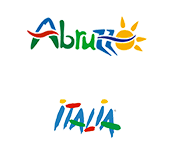
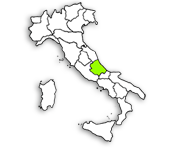
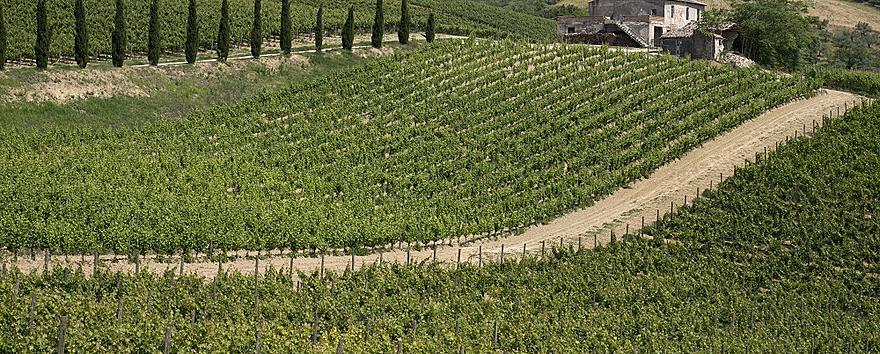
From the flanks of the Maiella and Gran Sasso the land slopes gently across the countryside and villages in the rolling hills around Pescara to the fish-rich Adriatic. Just 18 municipalities cover the whole area.
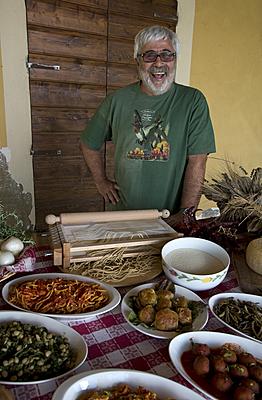
SUGGESTIONS
Amid olive presses and wineries The hills of Pescara recede gently between sea and mountain in a Mediterranean landscape. As far as the eye can see vineyards stretch away with vines trained in ancient canopies or modern cordons, interspersed with groves of gnarled olive trees. Here it is wonderful to wander amid wineries and olive presses, savouring the flavours of the land.
Old Pescara The city is the birthplace of the poet Gabriele d’Annunzio. The lower town of old Pescara encloses a world that is worth exploring at the table. Corso Manthonè, Via delle Caserme and Via dei Bastioni form the boundaries of this precinct where restaurants and “taverns” will enable you to discover the city’s gift for hospitable dining.
Rural landscapes The countryside around Pescara unfolds between vineyards, olive groves, hills and villages set in the countryside. One of the temples where the essence of the land emerges most clearly is the abbey of S. Maria in Piano at Loreto Aprutino. A little jewel, it contains a monumental Last Judgement in the midst of a land where peasant civilisation has left an enduring architectural monument.
Starter of the sea and fish soup Hot or cold, cooked or raw: in Pescara and its environs you can eat your fill of seafood delicacies. Brodetto is an exquisite soup but you have to sample it in Pescara: made with the morning’s catch using extra virgin olive oil, firfellone (dried red chilies), parsley and garlic.
Tondino del Tavo The Tondino bean is grown in the Tavo Valley, between Farindola, Cappelle and Loreto Aprutino, the town where its production is highest. This small white pulse, round and thin-skinned, is excellent just boiled and dressed simply with Aprutino Pescarese Olive Oil DOP, and is the basis for numerous traditional recipes.
FOOD & PLACES
The historic centre of Loreto Aprutino The town lies in the hills, immersed in the silent flow of rural life. The past emerges in the façades of the noble palaces of the old town, streets resonant with footsteps and the pealing of church bells, its many museums and the city’s majestic castle, recently restored.
Museums in Pescara The old Museo delle Genti d’Abruzzo offers a journey through the history of the region’s peoples. Housed in the rampart overlooking the old town, it is just a stone’s throw from d’Annunzio’s birthplace on the river. A hundred yards away is the Cenacolo di Cascella, once a gathering place for artists, today a museum. On the seafront stands the Museo del Mare, with its specimens of fish, fossils, sea shells and fishing gear.
Markets in Pescara Fish is still sold on the north wharf of Pescara’s port or in the fish market nearby. The produce of the countryside is sold directly by farmers in the Campagna Amica covered market, adjoining the fish market, in Via Paolucci and on some stalls in the covered markets on Via dei Bastoni and Largo Muzii, where the produce is chosen one at a time, as in the past.
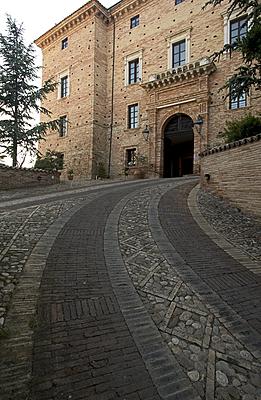 Wines of the Pescara Hills A succession of hills between Maiella and the Adriatic, a green expanse dotted with olive trees and vines: here we are in the noble homeland of Montepulciano. Between gentle hills and ancient villages, grapes have been grown here from time immemorial, now with ancient expertise and modern techniques. Valentini is one of the great names in wine, but there are also a multitude of craft wineries and major cooperatives that attain quality and consistency. The wines of this region are rich and Mediterranean, elegant and fragrant. They are perfect with food: from the powerful and ambitious Montepulciano d’Abruzzo to the ever more refined Trebbiano, with its complexity and acids intact, and some delightful wines made from indigenous grape varieties.
Wines of the Pescara Hills A succession of hills between Maiella and the Adriatic, a green expanse dotted with olive trees and vines: here we are in the noble homeland of Montepulciano. Between gentle hills and ancient villages, grapes have been grown here from time immemorial, now with ancient expertise and modern techniques. Valentini is one of the great names in wine, but there are also a multitude of craft wineries and major cooperatives that attain quality and consistency. The wines of this region are rich and Mediterranean, elegant and fragrant. They are perfect with food: from the powerful and ambitious Montepulciano d’Abruzzo to the ever more refined Trebbiano, with its complexity and acids intact, and some delightful wines made from indigenous grape varieties.
DOP Aprutino Pescarese Dritta, Leccino and Toccolana are hardy, prized olive varieties used to make Aprutino Pescarese extra virgin olive oil PDO, one of the first five protected designations of origin granted by the European Union. The production area lies in the province of Pescara, between the Gran Sasso and Maiella, the Vestine and Casauriense hills, the upper valley of the Pescara River and the coast. The name Aprutino comes from “Aprutium”, a place name associated with the Vestini, a pre-Roman population.
Parrozzo The name is a contraction of pane rozzo (“coarse bread”), but it is a delicious cake made from almonds and chocolate, so scrumptious that d’Annunzio dedicated a madrigal to it, making it famous beyond the bounds of Pescara. Its slightly bitter taste suggests Pescara’s history and land. The dough for it is still hand-kneaded.
Mugnaia di Elice Hand-made pasta with a sauce of pork, mutton (castrato) and cheese, a rustic dish invented by millers at their water mills on the Fino River. One measure of durum wheat flour is used to a quarter of soft wheat, salt and water and the dough worked skilfully with the fingertips into long strands. The name comes from the small medieval town of Elice (whose name derives in turn from the Latin Ilex, ilicis, or leccio in Italian, the evergreen holm oak).
Porchetta Porchetta (roast sucking pig) fosters sociability as well as hearty eating. It has now become the most common street food. Two or three types are all the rage here, and are available in stores, but the authentic “porchettaro” is the one who sells his wares in the street, at the market, at festivals...
Poultry and rabbits Some domestic barnyards and cattle sheds linger on:among the hills of Pescara chickens, hens, rabbits, turkeys, geese and Muscovy ducks are not uncommon. Their meat, roasted, stewed, braised or in soups, recalls the rustic flavours of the past, while their eggs are an important source of protein.
Vino Cotto The must leftover from pressing red and white grapes is boiled for hours at a high temperature in a large copper or steel vessel. Once the water has evaporated the organic components are processed into a concentrate which is cooled and combined with the first pressing of the must. It is then fermented and aged in small wooden barrels for periods of between one and forty years or more. It is best drunk after a meal while sampling the local cookies.
Craft beer The innovative project of the Spoltore Polo della Birra Artigianale plans to relaunch the town’s image, economy and tourist trade, making it a national centre for brewing. This is an area that is home to established producers such as Jurij Ferri, Almond’s master brewer, reputed among the top ten in Italy, the pioneer and inspirer of the independent brewery movement growing rapidly in the centre-south.
Book your holiday
Weather forecast
Traveller information
Contact us »
+39.085.8561222
info@terrepescaresi.it
Our travel offers
Exclusive experiences

Gran Sasso d'Italia
Follow us!
